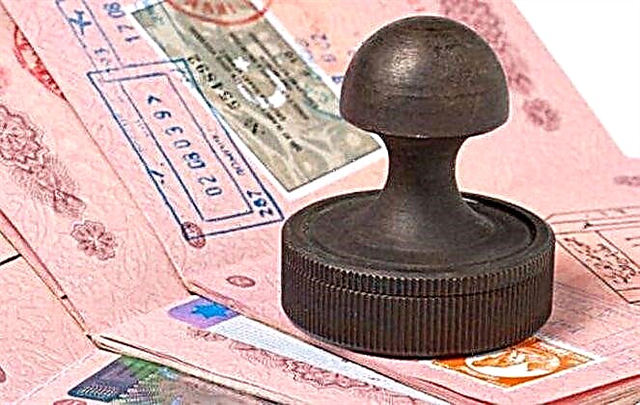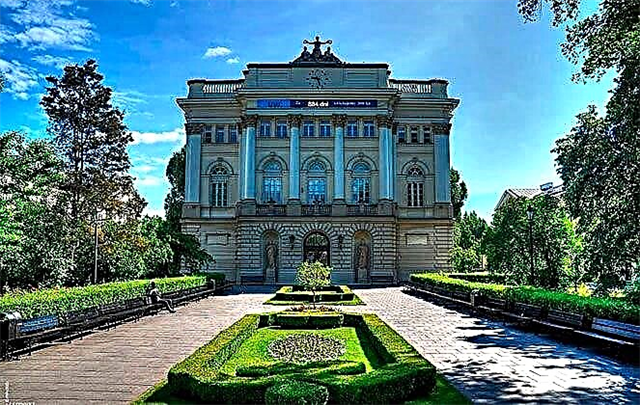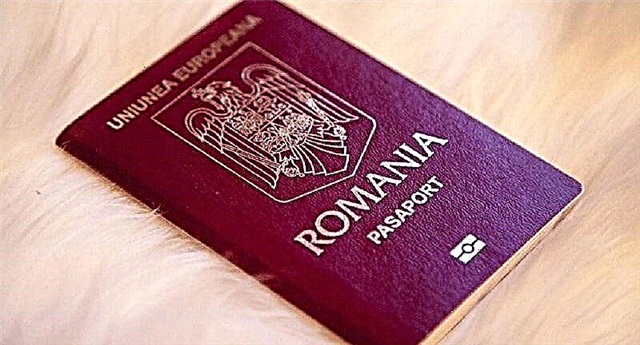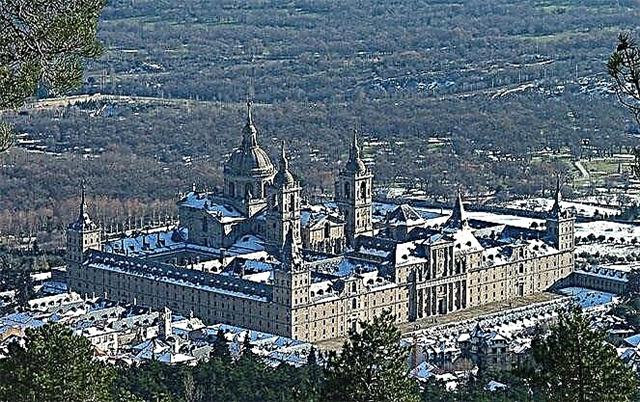Greatness without luxury, nobility devoid of arrogance, simplicity and seriousness - these are the instructions that the architect received from Philip II, who designed one of the most monumental architectural monuments in the world - San Lorenzo de El Escorial in Spain. Today, the palace is included in the list of sites under the protection of UNESCO, and is the pride of the Spaniards themselves, who consider it nothing more than the eighth wonder of the world.

Construction history
In Spanish travel guides, you can read that El Escorial is a continuation of the Sierra de Guadarrama mountain range. And although in fact this is not entirely true, the building looks quite harmoniously against the background of the harsh landscape of this part of the country. If you want to experience what real greatness means, which weighs on you with its history and scale, then you are in Madrid.
The place where the building is located cannot be called welcoming. Those who plan to add it to their tourist route will have to bring warm clothes with them, because it is always cool and windy here, and even in the hottest summer indoors, you can freeze.
Escorial is a huge rectangle located northwest of the Spanish capital. Its size is 207 by 161 meters.
For the construction, granite was used, which is considered a difficult material to work with. But, even taking this circumstance into account, the building was erected in a record time for those times - in 21 years.
The construction of this architectural monument began on April 23, 1563 at the initiative of Philip II. The reason for the start of work was the battle between the French and the Spaniards at Saint-Quentin, in which the subjects of the Spanish King Philip won.

An important event in the history of the monarch's reign was overshadowed by the fact that during the battle his soldiers accidentally destroyed the monastery, which bore the name of the noble Spaniard - St. Lawrence.
To atone for his guilt, the king of Spain decided to build a palace that would have no equal in the whole world. According to his idea, the building was supposed to represent an inverted lattice, on which the saint revered by his people burned down alive. The four corner towers represented the legs of the lattice, and the Palace of the Infants, protruding forward, represented the handle.
A few facts about the architects of the palace:
- The author of the project was Juan Bautista de Toledo, who in his early years worked on the construction of St. Peter's Basilica in Italy. At that time, he was the assistant to the great Michelangelo.
- The construction was constantly corrected by Philip II with numerous amendments and recommendations. Therefore, he may well be considered a co-author of the structure.
- Toledo died in 1567 without seeing the completion of one of his grandiose creations (the Escorial was completed in 1584).
- De Toledo's place was taken by an equally talented master - Juan de Herrera. A whole trend in architecture was associated with his name in Spain - Erreresco, which was characterized by laconic detail and the absence of decorative elements.
According to skeptical researchers, the architectural idea of Escorial's authors cannot be considered original. They claim that similar buildings in Cambridge and Milan served as prototypes for the palace. In addition, they argue that the Alhambra in Granada and the Alcazar in Seville could also have been the prototypes of the palace.
In addition to the official version, there is also a legend about the creation of Escorial. Devout Spaniards pass on the story from generation to generation that the building was built to close the "Gate to Hell", which they say is at the foot of the Guadamarra Mountains. Added fuel to the fire and the fact that after the completion of construction, Philip brought here a large collection of books on occult magic, which he hid from the Inquisition.
What the palace includes
The length of the corridors in the building is 24 km. The complex includes:
- 9 towers;
- 13 chapels;
- 16 courtyards;
- 1860 rooms;
- 86 internal staircases;
- about 2670 windows (the exact number has not yet been calculated even today).
The monastic and palace ensemble is oriented to 4 cardinal directions (there is a slight error). The main (western façade) overlooks a spacious square. This part of the castle has two floors and a 12-column portico.

El Escorial's map looks like this:
- the front door leads to the Court of Kings. On its opposite side is the entrance to the main part of the entire building - the Basilica of St. Lorenzo. If you face her, then on the right will be the cells of the monks, on the left - the seminaries, including the premises where the El Escorial Boys Choir is engaged;
- the entrance to the basilica is marked by a portico, on both sides of which there are 2 bell towers (each is 72 meters high). Behind it, tourists will find the Royal Pantheon, then - the palace of Philip II. Due to his extreme piety, he insisted that his private chambers be located next to the altar of the temple. This allowed him in his old years to be present at the service without getting out of bed (the king was tormented by gout);
- on the left side of the basilica is the Bourbon Palace, which was the residence of the Spanish monarchs who ruled the country since 1715;
- to the right of the basilica are the monastery premises that surround the Evangelists' Court;
- part of the façade facing east is occupied by the Pantheon of the Infants. The princesses and princes of the Spanish royal family are buried here;
- the western and eastern facades open onto lush gardens, also designed by Philip II;
- the southern and northern facades are fortified walls devoid of decor.
Not far from the palace (9 km) in the 40s of the last century, the Valley of the Fallen memorial was built, dedicated to the soldiers who died during the Civil War.
A little about the Pantheon
The Pantheon was conceived by the Spanish monarch as the tomb of kings. All the monarchs of Spain who ruled the country since 1586 are buried here. At the moment, only three tombs are empty, but there are already applicants for them.
The last departed Spanish rulers will be buried here. But first, according to the still practiced medieval tradition, they have 50 years of so-called waiting in a special room called the "rotting room." From this we can conclude that there is no longer a place for the current ruling members of the royal family in the Pantheon. And this question is still open.

The tomb contains 26 sarcophagi made of marble and jasper, and covered with gold. They are located in 4 rows.
Among those who rest here, there is only Philip the Fifth (buried in Segovia), Ferdinand the Sixth (his grave is in Madrid) and Amadeo of Savoy (found peace in the city of Turin). The last person to be buried here was Alfonso the Thirteenth.
The kings are buried here along with their wives, who (each in their own time) became the mothers of the heirs to the throne. Other wives rest in the Pantheon of the Infants. It also contains the tombs of princes and princesses. The gaze freezes at the marble mausoleum in the form of a cake, in which the bodies of young rulers who have not lived to adulthood rest.
El Escorial museums
There are two museums in the building:
- Architectural - tells the story of the construction of El Escorial. Here you can find three-dimensional models of a building, drawings, drawings, construction tools.
- Artistic - includes more than 5,000 paintings by famous foreign and Spanish masters from Bosch (by the way, there are more of his canvases here than in Madrid's Prado) to Titian.
The collection of paintings that tourists can find in the museum today was started by King Philip II. There is a small information stand next to each canvas.

The heritage of the palace also includes ancient tapestries, incredibly beautiful stained-glass windows, mosaic panels, arches, passages.
Picture halls
The collection of canvases presents unique works by masters of various schools. Today are presented here:
- the canvases of the famous Flemish Rogier van der Weyden;
- the heritage of the Spanish and Italian schools - the works of Velazquez, El Greco, Titian, Bosch, Tintoretto;
- a collection of wall hangings that were woven from sketches by Rubens and Goya
From the art gallery, visitors enter the Halberd Hall (or Battle Hall). The walls and ceiling of this room are decorated with frescoes depicting the military triumphs of the Spanish people.

This is followed by the Hall of Maps, where you can find schematic images of the "old" world. Some of them do not yet have France, but there are Burgundy and Flanders.
A little time can be devoted to the room where the portraits of all the Habsburgs are kept, which can be recognized by the slightly protruding lower lip and bulging eyes.
El Escorial Library
The size of the royal repository of valuable tomes is second only to the Vatican Library. The total number of books is about 40 thousand and almost 3 thousand more manuscripts. Interesting fact: the El Escorial Library is the only place in the world where books are stored on shelves with the spines inward. This is done in order to protect the precious bindings from damage.
Once upon a time, Pope Gregory the Thirteenth issued a decree stating that anyone who attempts to steal at least one copy from the library will be excommunicated forever.

Once in this repository of valuable copies of prints, lift your head and look at the ceiling. It metaphorically presents arts and sciences - rhetoric, mathematics, dialectics, music, astronomy and others. The idea to decorate the vault in this way belongs to Tybaldi, who worked for Escorial with his daughter.
The El Escorial collection includes:
- Arabic manuscripts;
- meeting of the Sultan of Morocco Zidane Abu Mali;
- works of medieval cartographers;
- works of historians, doctors;
- church literature;
- unique handwritten works of St. Augustine and Teresa of Avila.
Who collected these books and for what purpose, history is not known.
Palace cathedral
Most of all, in this part of the complex, the frescoes that adorn the ceilings and the entire space behind the altar are striking. The authorship of the works belongs to Spanish artists. There are also paintings in gilded frames depicting biblical motives - the life of the Virgin Mary and Christ.
On the opposite side are statues of Philip II, Charles V and their family members during prayer. There is a monastery adjoining the cathedral, which has about 300 cells.

The basilica is made in the form of a Greek cross (all sides are equal). The dome resembles the one that we see in St. Peter's Basilica (Rome).
In general, the appearance of the basilica can be called majestic, austere, austere. Only the space behind the altar is distinguished by the richness of the decor. It was assumed that the issue of painting it would be entrusted to Titian and Michelangelo. But both of them were already over 80 years old by that time.
The cathedral's treasury contains about 7.5 thousand relics, including the remains of saints and martyrs.
Palace gardens and squares
The gardens of El Escorial are no less great. After walking through the numerous halls and rooms, do not miss the opportunity to relax in one of them located in the southern and eastern parts of the building. The gardens were laid out on the initiative of King Philip and have the form of intricate figures and labyrinths, among which are graceful fountains.

It is free to enter the gardens, but the gates leading to this part of the complex open according to the opening hours of the entire museum. There is a small pond with swans at the very entrance, and peacocks are walking in a remote part of the park. From here you can also admire the de Guadamarra mountain range and the monastery orchards.
On the territory of the palace complex there is a spacious square, which is called "lonha" here. The decoration of this part of El Escorial is the statue of Philip, who seems to be watching the most magnificent creation of his life.
Royal armchair
In Spanish, this place sounds like Silla de Felipe II. But do not look for anything in the palace that even remotely resembles a four-legged chair.
"Philip's Chair" is the name of the observation deck on the slopes of the mountains, from which the monarch watched the progress of the construction of the Escorial.
This place is located 6 km from the palace. In order not to get lost, you can immediately ask for a map at the entrance to the museum on how to get to this point.

Get ready for the thorny and difficult path here, but the climb is worth it. Only from here can you see that the El Escorial building really has the shape of a lattice on which St. Lawrence was burned alive.
To help a tourist
Organizing a trip to this part of Spain on your own will not be difficult. The palace complex is only 50 km away from Madrid.
There are two ways to get here:
- by train - departures from Atocha and Chamartin stations. They both walk to the El Escorial stop. Then walk from the railway station for about 20 minutes (1.5 km).
- by bus - lines 664 and 661. Depart from the Intercambiador Moncloa terminal and go as far as El Escorial. Travel time is 1 hour. The return flight will board at the bus station near the Calle Juan de Toledo monastery.
Tickets will cost about 7-20 euros one way.
Opening hours of the palace complex:
- October-March: Tuesday-Sunday 10.00-18.00;
- April September: Tuesday-Sunday 10.00-20.00;
- Monday is a day off.
The entrance ticket costs 10 euros.
What else to see in Spain
The Spanish kingdom with its history, culture and heritage is rightfully considered an open-air museum. Here is just a small list of what you definitely need to visit during your visit:
- Sagrada Familia or Sagrada Familia (Barcelona). An unrivaled project by the famous Antoni Gaudi. Construction began back in 1882. It is considered the largest long-term construction project on the planet, since it is being built exclusively with the money of the parishioners.
- Prado Museum in Madrid. The collection of paintings includes about 8600 works of great artists. In addition to painting, there are Dauphin's treasures, examples of decorative art, Italian sculptures.
- Burgos Cathedral - Cathedral of the Virgin Mary located in Burgos. The third largest temple in Spain. Combines three styles: Baroque, Gothic and Renaissance.
- Plaza de España (Sevilla) is one of the most beautiful squares in the world. There is a fountain in its center, and a canal has been dug around the square itself, along which you can ride a boat.
- Park Guell is another creation by Antoni Gaudi. Built in the style of a gingerbread house. On its territory there are many alleys, benches, vaults and columned halls.
- The ancient city of Cuenca is located on the top of a cliff at an altitude of 956 meters above sea level. It arose as a settlement of the Celts at the very beginning of a new era. Outlived the Arabs, Moors, Romans. Over time, the houses began to look like an extension of the rocks.
The list is endless: the cathedral-mosque of the Mesquita in Cordoba, the Alhambra Museum of Islamic Culture in Granada, the Palace of the Kings in Madrid, Casa Batlló in Barcelona, the Alcazar of Seville and many others.
Outcomes
The Escorial palace complex is located 50 km from the Spanish capital. Its construction began on the initiative of the Spanish king Philip II and lasted 21 years. On the territory of the complex there is a royal palace, the tomb of all Spanish monarchs, a gymnasium, a monastery, two museums, gardens and a large square overlooking Madrid and the mountains.











